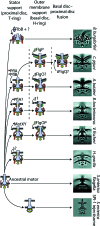Insights into the evolution of bacterial flagellar motors from high-throughput in situ electron cryotomography and subtomogram averaging
- PMID: 29872008
- PMCID: PMC6096493
- DOI: 10.1107/S2059798318007945
Insights into the evolution of bacterial flagellar motors from high-throughput in situ electron cryotomography and subtomogram averaging
Abstract
In situ structural information on molecular machines can be invaluable in understanding their assembly, mechanism and evolution. Here, the use of electron cryotomography (ECT) to obtain significant insights into how an archetypal molecular machine, the bacterial flagellar motor, functions and how it has evolved is described. Over the last decade, studies using a high-throughput, medium-resolution ECT approach combined with genetics, phylogenetic reconstruction and phenotypic analysis have revealed surprising structural diversity in flagellar motors. Variations in the size and the number of torque-generating proteins in the motor visualized for the first time using ECT has shown that these variations have enabled bacteria to adapt their swimming torque to the environment. Much of the structural diversity can be explained in terms of scaffold structures that facilitate the incorporation of additional motor proteins, and more recent studies have begun to infer evolutionary pathways to higher torque-producing motors. This review seeks to highlight how the emerging power of ECT has enabled the inference of ancestral states from various bacterial species towards understanding how, and `why', flagellar motors have evolved from an ancestral motor to a diversity of variants with adapted or modified functions.
Keywords: bacterial flagellar motors; electron cryotomography; low-abundance imaging; molecular evolution; subtomogram averaging.
open access.
Figures





Similar articles
-
Diverse high-torque bacterial flagellar motors assemble wider stator rings using a conserved protein scaffold.Proc Natl Acad Sci U S A. 2016 Mar 29;113(13):E1917-26. doi: 10.1073/pnas.1518952113. Epub 2016 Mar 14. Proc Natl Acad Sci U S A. 2016. PMID: 26976588 Free PMC article.
-
In Situ Structure of the Vibrio Polar Flagellum Reveals a Distinct Outer Membrane Complex and Its Specific Interaction with the Stator.J Bacteriol. 2020 Jan 29;202(4):e00592-19. doi: 10.1128/JB.00592-19. Print 2020 Jan 29. J Bacteriol. 2020. PMID: 31767780 Free PMC article.
-
In Situ Structural Analysis of the Spirochetal Flagellar Motor by Cryo-Electron Tomography.Methods Mol Biol. 2017;1593:229-242. doi: 10.1007/978-1-4939-6927-2_18. Methods Mol Biol. 2017. PMID: 28389958
-
Structural basis of torque generation in the bi-directional bacterial flagellar motor.Trends Biochem Sci. 2022 Feb;47(2):160-172. doi: 10.1016/j.tibs.2021.06.005. Epub 2021 Jul 19. Trends Biochem Sci. 2022. PMID: 34294545 Review.
-
Molecular motors of the bacterial flagella.Curr Opin Struct Biol. 2008 Dec;18(6):693-701. doi: 10.1016/j.sbi.2008.09.006. Epub 2008 Oct 24. Curr Opin Struct Biol. 2008. PMID: 18848888 Review.
Cited by
-
The Dynamic Ion Motive Force Powering the Bacterial Flagellar Motor.Front Microbiol. 2021 Apr 13;12:659464. doi: 10.3389/fmicb.2021.659464. eCollection 2021. Front Microbiol. 2021. PMID: 33927708 Free PMC article. Review.
-
FliL and its paralog MotF have distinct roles in the stator activity of the Sinorhizobium meliloti flagellar motor.Mol Microbiol. 2022 Sep;118(3):223-243. doi: 10.1111/mmi.14964. Epub 2022 Jul 28. Mol Microbiol. 2022. PMID: 35808893 Free PMC article.
-
The "Jack-of-all-Trades" Flagellum From Salmonella and E. coli Was Horizontally Acquired From an Ancestral β-Proteobacterium.Front Microbiol. 2021 Mar 30;12:643180. doi: 10.3389/fmicb.2021.643180. eCollection 2021. Front Microbiol. 2021. PMID: 33859630 Free PMC article.
-
Bacterial flagella hijack type IV pili proteins to control motility.Proc Natl Acad Sci U S A. 2024 Jan 23;121(4):e2317452121. doi: 10.1073/pnas.2317452121. Epub 2024 Jan 18. Proc Natl Acad Sci U S A. 2024. PMID: 38236729 Free PMC article.
-
Flagella, Chemotaxis and Surface Sensing.Adv Exp Med Biol. 2022;1386:185-221. doi: 10.1007/978-3-031-08491-1_7. Adv Exp Med Biol. 2022. PMID: 36258073
References
Publication types
MeSH terms
Substances
Grants and funding
LinkOut - more resources
Full Text Sources
Other Literature Sources

